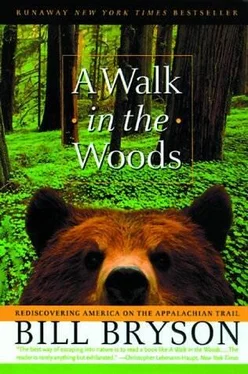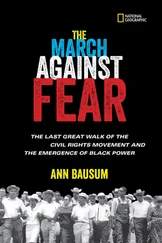Bill Bryson - A Walk In The Woods
Здесь есть возможность читать онлайн «Bill Bryson - A Walk In The Woods» весь текст электронной книги совершенно бесплатно (целиком полную версию без сокращений). В некоторых случаях можно слушать аудио, скачать через торрент в формате fb2 и присутствует краткое содержание. Жанр: Современная проза, на английском языке. Описание произведения, (предисловие) а так же отзывы посетителей доступны на портале библиотеки ЛибКат.
- Название:A Walk In The Woods
- Автор:
- Жанр:
- Год:неизвестен
- ISBN:нет данных
- Рейтинг книги:4 / 5. Голосов: 1
-
Избранное:Добавить в избранное
- Отзывы:
-
Ваша оценка:
- 80
- 1
- 2
- 3
- 4
- 5
A Walk In The Woods: краткое содержание, описание и аннотация
Предлагаем к чтению аннотацию, описание, краткое содержание или предисловие (зависит от того, что написал сам автор книги «A Walk In The Woods»). Если вы не нашли необходимую информацию о книге — напишите в комментариях, мы постараемся отыскать её.
A Walk In The Woods — читать онлайн бесплатно полную книгу (весь текст) целиком
Ниже представлен текст книги, разбитый по страницам. Система сохранения места последней прочитанной страницы, позволяет с удобством читать онлайн бесплатно книгу «A Walk In The Woods», без необходимости каждый раз заново искать на чём Вы остановились. Поставьте закладку, и сможете в любой момент перейти на страницу, на которой закончили чтение.
Интервал:
Закладка:
It was more than a little discouraging. The best I could do was to do, well, the best I could do. Anyway, I had to try. Everyone in town who knew me (not a huge number, admittedly, but enough to have me forever dodging into doorways whenever I saw a familiar face approaching along Main Street) knew that I was trying to hike the AT, which patently I could not be doing if I was to be seen skulking in town. (“I saw that Bryson fellow today slipping into Eastman’s Pharmacy with a newspaper in front of his face. I thought he was supposed to be hiking the Appalachian Trail. Anyway, you’re right. He is odd.”)
It was clear I had to get back on the trail-properly back on, far from home, somewhere at least reasonably proximate to northern Virginia -if I was to have any pretense of hiking the trail with anything approaching completeness. The problem was that it is almost impossible nearly everywhere along the AT to get on and off the trail without assistance. I could fly to Washington or Newark or Scranton, or any of several other places in the region of the trail, but in each case I would still be scores of miles short of the trail itself. I couldn’t ask my dear and patient wife to take two days to drive me back to Virginia or Pennsylvania, so I decided to drive myself. I would, I figured, park at a likely looking spot, take a hike up into the hills, hike back to the car, drive on a way, and repeat the process. I suspected this would turn out to be fairly unsatisfying, possibly even imbecile (and I was right on both counts), but I couldn’t think of a better alternative.
And thus I was to be found, in the first week of June, standing on the banks of the Shenandoah again, in Harpers Ferry, West Virginia, blinking at a grey sky and trying to pretend that with all my heart this was where I wanted to be.
Harpers Ferry is an interesting place for a number of reasons. First, it is quite pretty. This is because it is a National Historical Park, so there are no Pizza Huts, McDonald’s, Burger Kings, or even residents, at least in the lower, older part of town. Instead, you get restored or re-created buildings with plaques and interpretation boards, so it doesn’t have much, or indeed any, real life, but it still has a certain beguiling, polished prettiness. You can see that it would be a truly nice place to live if only people could be trusted to reside there without succumbing to the urge to have Pizza Huts and Taco Bells (and personally I believe they could, for as much as eighteen months), so instead you get a pretend town, attractively tucked between steep hills at the confluence of the Shenandoah and Potomac Rivers.
It is a National Historical Park because, of course, it is a historic place. It was at Harpers Ferry that the abolitionist John Brown decided to liberate America’s slaves and set up a new nation of his own in northwestern Virginia, which was a pretty ambitious undertaking considering that he had an army of just twenty-one people. To that end, on October 16, 1859, he and his little group stole into town under cover of darkness, captured the federal armory without resistance (it was guarded by a single night-watchman), yet still managed to kill a hapless passerby-who was, ironically, a freed black slave. When news got out that a federal armory with 100,000 rifles and a great deal of ammunition was in the hands of a small band of lunatics, the president, James Buchanan, dispatched Lt. Col. Robert E. Lee (at that time still a loyal Union soldier, of course) to sort things out. It took Lee and his men less than three minutes of fighting to overcome the hapless rebellion. Brown was captured alive, swiftly tried, and sentenced to be hanged a month hence.
One of the soldiers sent to oversee the hanging was Thomas J. Jackson-soon to become famous as Stonewall Jackson-and one of the eager onlookers in the crowd was John Wilkes Booth. So the capture of the federal armory at Harpers Ferry served as quite a neat overture for all that followed. Meanwhile, in the wake of Brown’s little adventure, all hell was breaking loose. Northern abolitionists like Ralph Waldo Emerson made Brown a martyr, and Southern loyalists got up in arms, quite literally, at the idea that this might be the start of a trend. Before you knew it, the nation was at war.
Harpers Ferry remained at the center of things throughout the exuberantly bloody conflict that followed. Gettysburg was just thirty miles to the north, Manassas a similar distance to the south, and Antietam (where, it is worth noting, twice as many men died in one day as the total American losses in the War of 1812, Mexican War, and Spanish-American War combined) was just ten miles away. Harpers Ferry itself changed hands eight times during the war, though the record in this regard belongs to Winchester, Virginia, a few miles south, which managed to be captured and recaptured seventy-five times.
These days, Harpers Ferry passes its time accommodating tourists and cleaning up after floods. With two temperamental rivers at its feet and a natural funnel of bluffs before and behind, it is forever being inundated. There had been a bad flood in the town six months before, and the park’s staff was still busy mopping out repainting, and carrying furnishings, artifacts, and displays down from upstairs storage rooms. (Three months after my visit, they would have to take everything back up again.) At one of the houses, two of the rangers came out the door and down the walk and nodded smiles at me as they passed. Both of them, I noticed, were packing sidearms. Goodness knows what the world is coming to when park rangers carry service revolvers.
I had a poke around the town, but nearly every building I went to had a locked door and a notice saying“CLOSED FOR FLOOD REPAIRS.” Then I went and looked at the spot where the two rivers flow together. There was an Appalachian Trail notice board there. Although it had been only about ten days since the two women were murdered in Shenandoah National Park, there was already a small poster appealing for information. It had color photographs of them both. They were clearly photos taken by the women themselves along the trail, in hiking gear, looking happy and healthy, radiant even. It was hard to look at them, knowing their doom. It occurred to me, with a small inward start, that had the two women lived they would very probably be arriving in Harpers Ferry just about now, that instead of standing here looking at a poster of them I could be chatting with them-or indeed, given a slight alteration of luck and fate, that it could be them looking at a poster of me and Katz looking trail-happy and confident.
In one of the few houses open I found a friendly, well-informed, happily unarmed ranger named David Fox, who seemed surprised and pleased to have a visitor. He bobbed up instantly from his stool when I came in and was clearly eager to answer any questions. We got to talking about preservation, and he mentioned how hard it was for the Park Service with so little funds to do a proper job. When the park had been formed, there had been money enough to buy only about half of the Schoolhouse Ridge Battlefield above town (one of the most important if least celebrated of Civil War battle sites) and now a developer was in the process of building houses and shops on what Fox clearly saw as hallowed ground. The developer had even started running pipes across National park land in the confident-but, as it happened, mistaken-presumption that the Park Service wouldn’t have the will or money to stop him. Fox told me I should go up and look at it. I said I would.
But first I had a more important pilgrimage to make. Harpers Ferry is the headquarters of the Appalachian Trail Conference, overseers of the noble footpath to which I had dedicated my summer. The ATC occupies a modest white house on a steep hill above the old part of town. I trudged up and went in. The HQ was half office/half shop-the office portion commendably busy looking, the shop half arrayed with AT guides and keepsakes. At one end of the public area was a large-scale model of the entire trail, which, had I seen it before I started, might well have dissuaded me from attempting such an ambitious undertaking. It was perhaps fifteen feet long and conveyed arrestingly and at a glance what 2,200 miles of mountains look like: hard. The rest of the public area was filled with AT goods-T-shirts, postcards, bandannas, books, miscellaneous publications. I chose a couple of books and some postcards, and was served at the counter by a friendly young woman named Laurie Potteiger, whose badge described her as an Information Specialist, and they seem to have chosen the right person, for she was a mine of information.
Читать дальшеИнтервал:
Закладка:
Похожие книги на «A Walk In The Woods»
Представляем Вашему вниманию похожие книги на «A Walk In The Woods» списком для выбора. Мы отобрали схожую по названию и смыслу литературу в надежде предоставить читателям больше вариантов отыскать новые, интересные, ещё непрочитанные произведения.
Обсуждение, отзывы о книге «A Walk In The Woods» и просто собственные мнения читателей. Оставьте ваши комментарии, напишите, что Вы думаете о произведении, его смысле или главных героях. Укажите что конкретно понравилось, а что нет, и почему Вы так считаете.












